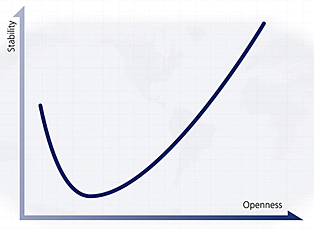Control theory deals with the control of dynamical systems in engineered processes and machines. The objective is to develop a model or algorithm governing the application of system inputs to drive the system to a desired state, while minimizing any delay, overshoot, or steady-state error and ensuring a level of control stability; often with the aim to achieve a degree of optimality.
A dictatorship is a form of government which is characterized by a leader or a group of leaders which holds governmental powers with few to no limitations on them. The leader of a dictatorship is called a dictator. Politics in a dictatorship take place between the dictator, the inner circle, and the opposition, which may be peaceful or violent. Dictatorships can be formed by a military coup that overthrows the previous government through force or by a self-coup in which elected leaders make their rule permanent. Dictatorships are authoritarian or totalitarian and can be classified as military dictatorships, one-party dictatorships, personalist dictatorships, or absolute monarchies.
A political spectrum is a system to characterize and classify different political positions in relation to one another. These positions sit upon one or more geometric axes that represent independent political dimensions. The expressions political compass and political map are used to refer to the political spectrum as well, especially to popular two-dimensional models of it.
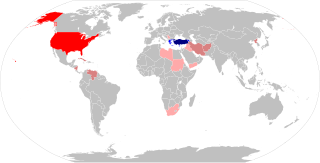
"Rogue state" is a term applied by some international theorists to states that they consider threatening to the world's peace. These states meet certain criteria, such as being ruled by authoritarian or totalitarian governments that severely restrict human rights, sponsoring terrorism, or seeking to proliferate weapons of mass destruction. The term is used most by the United States ; in his speech at the United Nations (UN) in 2017, U.S. President Donald Trump reiterated this phrase. However, it has been applied by other countries as well.
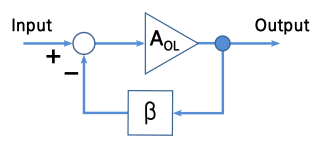
In electronics and control system theory, loop gain is the sum of the gain, expressed as a ratio or in decibels, around a feedback loop. Feedback loops are widely used in electronics in amplifiers and oscillators, and more generally in both electronic and nonelectronic industrial control systems to control industrial plant and equipment. The concept is also used in biology. In a feedback loop, the output of a device, process or plant is sampled and applied to alter the input, to better control the output. The loop gain, along with the related concept of loop phase shift, determines the behavior of the device, and particularly whether the output is stable, or unstable, which can result in oscillation. The importance of loop gain as a parameter for characterizing electronic feedback amplifiers was first recognized by Heinrich Barkhausen in 1921, and was developed further by Hendrik Wade Bode and Harry Nyquist at Bell Labs in the 1930s.
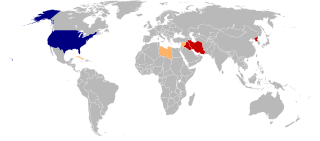
The phrase "axis of evil" was first used by U.S. President George W. Bush and originally referred to Iran, Iraq, and North Korea. It was used in Bush's State of the Union address on January 29, 2002, less than five months after the 9/11 attacks, and often repeated throughout his presidency. He used it to describe foreign governments that, during his administration, allegedly sponsored terrorism and sought weapons of mass destruction. The notion of such an axis was used to pinpoint these common enemies of the United States and to rally the American populace in support of the War on Terror. The countries originally covered by the term were Iran, Ba'athist Iraq, and North Korea. In response, Iran formed a political alliance that it called the "Axis of Resistance" comprising Iran, Syria and Hezbollah. Other countries were later added to the "axis of evil" by US politicians and commentators. The term “axis of evil” is itself a portmanteau of the Axis powers of WWII and the Cold War era “Evil Empire”.
Full employment is a situation in which there is no cyclical or deficient-demand unemployment. Full employment does not entail the disappearance of all unemployment, as other kinds of unemployment, namely structural and frictional, may remain. For instance, workers who are "between jobs" for short periods of time as they search for better employment are not counted against full employment, as such unemployment is frictional rather than cyclical. An economy with full employment might also have unemployment or underemployment where part-time workers cannot find jobs appropriate to their skill level, as such unemployment is considered structural rather than cyclical. Full employment marks the point past which expansionary fiscal and/or monetary policy cannot reduce unemployment any further without causing inflation.

A phase diagram in physical chemistry, engineering, mineralogy, and materials science is a type of chart used to show conditions at which thermodynamically distinct phases occur and coexist at equilibrium.
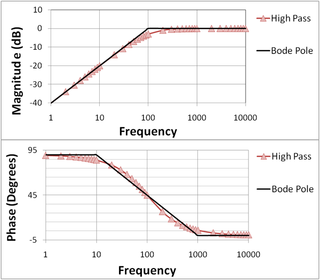
In electrical engineering and control theory, a Bode plot is a graph of the frequency response of a system. It is usually a combination of a Bode magnitude plot, expressing the magnitude of the frequency response, and a Bode phase plot, expressing the phase shift.
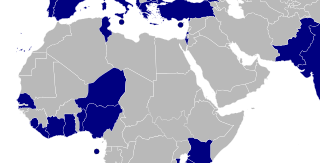
According to The Economist Group's Democracy Index 2020 study, Israel is the only democratic country in the Middle East, while Tunisia is the only democracy in North Africa. The level of democracy in nations throughout the world published by Freedom House, a U.S.-based, U.S. government-funded advocacy organization, and in various other freedom indices, report the Middle Eastern and North African countries with the highest scores are Israel, Tunisia, Turkey, Lebanon, Morocco, Jordan and Kuwait. Countries that have been consistently labelled as 'not free' by Freedom House (2017-2021) have been Iran, Iraq and Egypt. They have been increasingly becoming more and more adverse to the idea of liberal democracy with their scores steadily decreasing, only Iraq out of these countries have maintained some level of internet freedom with a score of 41/100. The remaining countries of the Middle East are categorised as authoritarian regimes, with the lowest scores held by Saudi Arabia and Yemen.
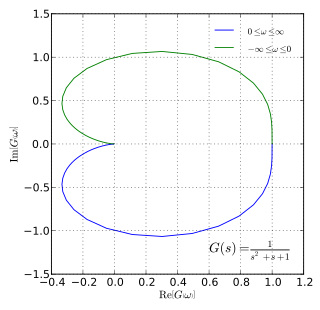
In control theory and stability theory, the Nyquist stability criterion or Strecker–Nyquist stability criterion, independently discovered by the German electrical engineer Felix Strecker at Siemens in 1930 and the Swedish-American electrical engineer Harry Nyquist at Bell Telephone Laboratories in 1932, is a graphical technique for determining the stability of a dynamical system. Because it only looks at the Nyquist plot of the open loop systems, it can be applied without explicitly computing the poles and zeros of either the closed-loop or open-loop system. As a result, it can be applied to systems defined by non-rational functions, such as systems with delays. In contrast to Bode plots, it can handle transfer functions with right half-plane singularities. In addition, there is a natural generalization to more complex systems with multiple inputs and multiple outputs, such as control systems for airplanes.

After the failure of the Embargo Act of 1807, the federal government of the United States took little interest in imposing embargoes and economic sanctions against foreign countries until the 20th century. United States trade policy was entirely a matter of economic policy. After World War I, interest revived. President Woodrow Wilson promoted such sanctions as a method for the League of Nations to enforce peace. However, he failed to bring the United States into the League and the US did not join the 1935 League sanctions against Italy. However, in 1940, the United States participated in the ABCD line against Japan, and the Helium Act of 1925 forbade the export of that strategic commodity. Interest in trade as a tool of foreign policy expanded during the Cold War era, and many economic sanctions were applied. The Comprehensive Anti-Apartheid Act of 1986, was only in effect for five years. Later, sanctions were additionally aimed against countries which the U.S. government listed as "State Sponsors of Terrorism".

Ian Arthur Bremmer is an American political scientist and author with a focus on global political risk. He is the president and founder of Eurasia Group, a political risk research and consulting firm with principal offices in New York City. He is also a founder of the digital media firm GZERO Media.
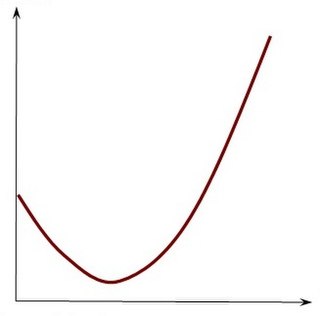
A J curve is any of a variety of J-shaped diagrams where a curve initially falls, then steeply rises above the starting point.
Authoritarianism is a political system characterized by the rejection of political plurality, the use of strong central power to preserve the political status quo, and reductions in the rule of law, separation of powers, and democratic voting. Political scientists have created many typologies describing variations of authoritarian forms of government. Authoritarian regimes may be either autocratic or oligarchic and may be based upon the rule of a party or the military. States that have a blurred boundary between democracy and authoritarianism have some times been characterized as "hybrid democracies", "hybrid regimes" or "competitive authoritarian" states.

American democracy promotion aims to encourage governmental and non-governmental actors to pursue political reforms that will lead ultimately to democratic governance.
Anocracy or semi-democracy is a form of government that is loosely defined as part democracy and part dictatorship, or as a "regime that mixes democratic with autocratic features." Another definition classifies anocracy as "a regime that permits some means of participation through opposition group behavior but that has incomplete development of mechanisms to redress grievances." The term "semi-democratic" is reserved for stable regimes that combine democratic and authoritarian elements. Scholars have also distinguished anocracies from autocracies and democracies in their capability to maintain authority, political dynamics, and policy agendas. Similarly, the regimes have democratic institutions that allow for nominal amounts of competition.
Authoritarian capitalism, or illiberal capitalism, is an economic system in which a capitalist market economy exists alongside an authoritarian government. Related to and overlapping with state capitalism, a system in which the state undertakes commercial activity, authoritarian capitalism combines private property and the functioning of market forces with repression of dissent, restrictions on freedom of speech and either a lack of elections or an electoral system with a single dominant political party.

The Elephant Curve, also known as the Lakner-Milanovic graph or the global growth incidence curve, is a graph that illustrates the unequal distribution of income growth for individuals belonging to different income groups. The original graph was published in 2013 and illustrates the change in income growth that occurred from 1988 to 2008. The x axis of the graph shows the percentiles of the global income distribution. The y axis shows the cumulative growth rate percentage of income. The main conclusion that can be drawn from the graph is that the global top 1% experienced around a 60% increase in income, whereas the income of the global middle increased 70 to 80%.
Democracy for the government of Iraq has been a long sought after goal by politicians, activists, and revolutionaries. Iraq has a score of 3.51 of ten (authoritarian) on the 2021 Democracy Index. Numerous wars and conflicts in Iraq have made it difficult for a stable democratic government to emerge. Since 1980, the country has only experienced 13 years in which they were not at war. Iraq's government has been in a political crisis since 2021.

